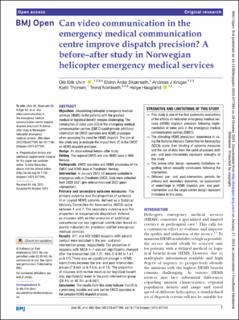| dc.contributor.author | Ulvin, Ole Erik Eide | |
| dc.contributor.author | Skjærseth, Eivinn Årdal | |
| dc.contributor.author | Krüger, Andreas Jørstad | |
| dc.contributor.author | Thorsen, Kjetil | |
| dc.contributor.author | Nordseth, Trond | |
| dc.contributor.author | Haugland, Helge | |
| dc.date.accessioned | 2024-03-19T12:29:19Z | |
| dc.date.available | 2024-03-19T12:29:19Z | |
| dc.date.created | 2023-11-10T12:54:06Z | |
| dc.date.issued | 2023 | |
| dc.identifier.citation | BMJ Open. 2023, 13 (10), e077395-?. | en_US |
| dc.identifier.issn | 2044-6055 | |
| dc.identifier.uri | https://hdl.handle.net/11250/3123122 | |
| dc.description.abstract | Abstract
Objectives Dispatching helicopter emergency medical services (HEMS) to the patients with the greatest medical or logistical benefit remains challenging. The introduction of video calls (VC) in the emergency medical communication centres (EMCC) could provide additional information for EMCC operators and HEMS physicians when assessing the need for HEMS dispatch. The aim of this study was to evaluate the impact from VC in the EMCC on HEMS dispatch precision.
Design An observational before–after study.
Setting The regional EMCC and one HEMS base in Mid-Norway.
Participants EMCC operators and HEMS physicians at the EMCC and HEMS base in Trondheim, Norway.
Intervention In January 2022, VC became available in emergency calls in Trondheim EMCC. Data were collected from 2020 2021 (pre-intervention) and 2022 (post-intervention).
Primary and secondary outcome measures The primary outcome was the proportion of seriously ill or injured HEMS patients, defined as a National Advisory Committee for Aeronautics (NACA) score between 4 and 7. The secondary outcome was the proportion of inappropriate dispatches, defined as missions with neither provision of additional competence nor any logistical contribution based on quality indicators for physician-staffed emergency medical services.
Results 811 and 402 HEMS missions with patient contact were included in the pre- and post-intervention group, respectively. The proportion of missions with NACA 4–7 was not significantly changed after the intervention (OR 1.21, 95% CI 0.92 to 1.61, p=0.17). There was no significant change in HEMS alarm times between the pre- and post-intervention groups (7.6 min vs 6.4 min, p=0.15). The proportion of missions with neither medical nor logistical benefit was significantly lower in the post-intervention group (28.4% vs 40.3%, p=0.007).
Conclusion The results from this study indicate that VC is a promising, feasible and safe tool for EMCC operators in the complex HEMS dispatch process.
Data availability statement
Data are available upon reasonable request. | en_US |
| dc.language.iso | eng | en_US |
| dc.publisher | BMJ | en_US |
| dc.rights | Navngivelse-Ikkekommersiell 4.0 Internasjonal | * |
| dc.rights.uri | http://creativecommons.org/licenses/by-nc/4.0/deed.no | * |
| dc.title | Can video communication in the emergency medical communication centre improve dispatch precision? A before-after study in Norwegian helicopter emergency medical services | en_US |
| dc.title.alternative | Can video communication in the emergency medical communication centre improve dispatch precision? A before-after study in Norwegian helicopter emergency medical services | en_US |
| dc.type | Journal article | en_US |
| dc.type | Peer reviewed | en_US |
| dc.description.version | publishedVersion | en_US |
| dc.source.pagenumber | e077395-? | en_US |
| dc.source.volume | 13 | en_US |
| dc.source.journal | BMJ Open | en_US |
| dc.source.issue | 10 | en_US |
| dc.identifier.doi | 10.1136/bmjopen-2023-077395 | |
| dc.identifier.cristin | 2195051 | |
| cristin.ispublished | true | |
| cristin.fulltext | original | |
| cristin.qualitycode | 1 | |

